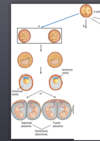Fertilization & Implantation Flashcards
(37 cards)
Where does fertilization occur?
In the ampulla of the fallopian tube.

In a 28 day menstruation cycle, ovulation occurs on day […].
14
[…] induces the primary oocyte to complete […] and to arrest in […]
LH surge
Meiosis 1
Metaphase 2 of meiosis 2
Describe the rupture of the ovary to release the follicle.

Once the secondary oocyte is released from the ovary into the peritoneum, how does it get into the fallopian tube?
Fimbriae of fallopian tube sweep it into the infundibulum of tube
Once a secondary oocyte is in the infundibulum of fallopian tube, how does it move within tube?
Tubal peristalsis moves the oocyte into the ampulla of the tube
Describe the transport of male gametes once ejaculated into the female vagina.
Ejaculate is deposited in upper vagina (fornix). Semen is alkaline so it protects sperm from acidic vaginal environment. Thin vaginal mucus also facilitates sperm function / survivial. Sperm are rapidly delivered to the fundus of the uterus within minutes due to rapid contraction of uterus. These sperm are not the ones that ultimately end up fertilizing the egg however. Instead, it is the slowly transported sperm that reach the fallopian tubes after 2-4 days that are most likely to fertilize the egg. The reason for this is b/c they must undergo capacitation and in order to fertilize.

What is capacitation of male gametes?

Once the slow transported sperm rech the fallopian tube, what do they do?
They bind to the isthumus epithelium for ~ 24 hours and undergo capacitation, then after capacitation they shed their cholesterol rich outer layer and are highly motile and have a burst of energy to carry them to the ampulla
What is the acrosome reaction and the Zona reaction?

Following penetration of the zona pellucida, the oocyte completes […] becoming the female […]
second meiotic division
Pronucleus
Describe the process of zygote formation once the egg has been penetrated by the sperm

What does ferilization accomplish?

What is cleavage?

The Morula consits of […] and enters the uterus on day […] after fertilization
20 blastomeres
4

Describe the formation of a blastocyst.
Trophoblast cells –> become placenta
Embryoblast cells –> give rise to all cells of embryo

Embryo enters the uterus on day […] after fertilization as a […]
5
Blastocyst

On day […] the blastocyst adheres to the endometrium
6
Describe the process of initial blastocyst implantation.
- When does it happen?
- What 2 cell populations are involved and how?
- What forms on the deep surface of the embryoblast?

When does the blastocyst become embedded into the endometrium?
Syncytiotrophoblasts invade deeper and embed blastocyst on day 8
When is blood supply for blastocyst established?
Invasion of maternal capillaries (spiral arterie) create lacunae, establishing primordial uteroplacental circulation on day 10




What is the luteal placental shift?
Initially, the corpus luteum secretes progesterone for 14 days. Around day 10, the blastocyst secretes hCG which keeps the corpus luteum from dying off as it normally would at the end of the 14 day cycle. The corpus luteum secretes progesterone to maintain the uterine environment until the embryo is able to establish its own circulation and matures to be able to secrete its own progesterone. This happens around week 8 (week 8 embryologically speaking, week 10 obstetrically speaking). At this point, progesterone starts to increase and hCG starts to decrease as the embryo is able to produce its own progesterone and no longer needs the corpus luteum.













